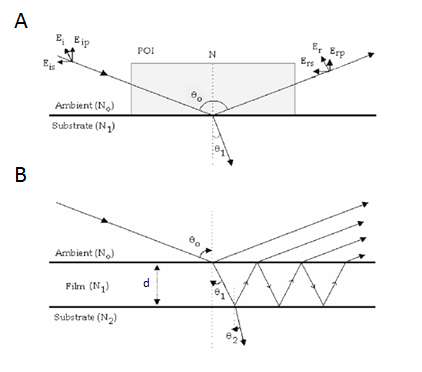Ellipsometry is an optical technique that can be used to measure the mass, thickness and refractive index of adsorbed layers. In the frame of this thesis, ellipsometry was used as the main method to quantify surface densities of end-grafted HA films and incorporated proteins, as well as binding affinities and kinetics of HA-protein interactions.
Working principle Ellipsometry is based on the measure of the changes in the polarization of elliptically polarized light upon reflection at the interface. Ellipsometry measures two parameters, the so-called ellipsometric angles Ψ and ∆. In order to obtain information about the thickness, refractive index and adsorbed mass, the measured Ψ and ∆ values need to be fitted with an adequate model Fujiwara, 2007.

Changes in the polarization of light upon reflection Maxwell theory describes light as an electromagnetic wave, where its electric component is characterized by two vectors : parallel (Ep) and perpendicular (Es) to the plane of incidence.Upon reflection from the surface, the phase and the amplitude of the reflected light are changed. The way how these parameters change depends on the optical properties of the adsorbed layer. For the reflection of lineary polarized light on a bare surface, the following equations are valid :

where δrp and δrs are phase shifts in parallel and perpendicular vectors, rp and rs are the complex Fresnel reflection coefficients for s- (perpendicular) and p- (parallel to the plane of incidence) polarized light. The relation between Ψ and ∆ can be expressed in the form of the ratio of the Fresnel coefficients :

The ratio rp/ rs depends on the wavelength (λ) of the incident light, the thickness of the film (d), the angle of incidence (Θ0), and the complex refractive index of the ambient, the adsorbed film and the substrate (N0, N1, and N2 respectively). Typically, N0, N2, λ and Θ0 are known parameters. Moreover, we work with transparent films, i.e. the refractive index of the film is real (N1 = n). The measured Ψ and ∆ can then be directly related to the properties of the film (n and d), i.e. the refractive index n and the film thickness d can be calculated through a fit to the experimental data. In particular for thick films, the thickness and refractive index of adsorbed layer can be fitted independently with good accuracy. In spectroscopic ellipsometry (SE), Ψ and ∆ are measured over a range of wavelengths, and n can then also be determined as a function of wavelength.
Determination of adsorbed mass Based on the measured n and d, the surface density (Γ) can be calculated according to de Feijter De Feijter et al., 1978 :

where d is the average thickness of the film, n1 is the refractive index of the film, n2 the (real) refractive index of the solution, and dn/dc is the so-called refractive index increment of the molecules that constitute the film. Within this work dn/dc values of 0.169, 0.18 and 0.15 ml/g were used for SLBs Reimhult et al., 2004Salamon & Tollin, 2001, proteins De Feijter et al., 1978 and HA Takahashi et al., 1999, respectively.
The change depends on the substrate properties, and the properties of the adsorbed layer, and can be measured by ellipsometry. N0, N1, and N2 are the complex refractive index of the ambient, the adsorbed film and the substrate, respectively. Θ0 is the angle of incidence, Θ1 the angle of transmission, Θ2 the angle of adsorption and d is the thickness of the adsorbed film.